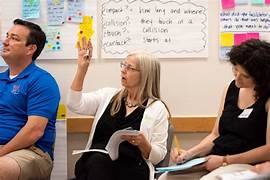Teacher professional development (PD) is a critical component of a successful education system. By providing teachers with opportunities to learn new skills, strategies, and knowledge, PD can help them improve their teaching and ultimately, the learning of their students.
There are many different types of PD available to teachers, from traditional workshops and conferences to more informal online courses and communities. The best type of PD for a particular teacher will depend on their individual needs and interests.
However, there are some general principles that all effective PD should follow. First, PD should be relevant to the teachers’ work. It should be based on the latest research on teaching and learning, and it should be tailored to the specific needs of the teachers and their students.
Second, PD should be active and engaging. Teachers should be actively involved in the learning process, rather than simply being passive recipients of information. They should have opportunities to collaborate with their colleagues, reflect on their practice, and apply what they are learning in their own classrooms.
Third, PD should be sustained over time. It is not enough for teachers to attend a one-day workshop and then go back to their classrooms and forget everything they learned. PD should be ongoing and embedded in the school culture.
When done well, teacher PD can have a significant impact on student learning. Studies have shown that teachers who participate in high-quality PD are more likely to use effective teaching practices, and their students are more likely to achieve at higher levels.
Here are some examples of effective teacher PD:
- Collaborative learning: Teachers can work together to learn new strategies and approaches to teaching. This can be done through professional learning communities, peer coaching, or lesson study.
- Data-driven decision-making: Teachers can use data to identify areas where their students need additional support. They can then use this information to plan and deliver instruction that is tailored to the needs of their students.
- Reflection: Teachers can reflect on their practice and identify areas where they can improve. This can be done through journaling, self-assessment, or peer feedback.
- Technology: Teachers can use technology to learn new skills and strategies, and to connect with other educators from around the world.
Teacher PD is an investment in the future of education. By providing teachers with the resources they need to improve their teaching, we can ensure that all students have the opportunity to succeed.
In addition to the general principles listed above, there are a few specific areas that are particularly important for teacher PD. These include:
- Instructional practices: PD should focus on helping teachers develop effective instructional practices. This includes learning about different teaching methods, how to differentiate instruction, and how to create a positive learning environment.
- Assessment: PD should also focus on helping teachers improve their assessment practices. This includes learning about different types of assessments, how to use assessments to inform instruction, and how to communicate assessment results to parents and students.
- Content knowledge: PD should help teachers stay up-to-date on the latest research in their content areas. This will help them to teach more effectively and to provide their students with the knowledge and skills they need to succeed.
By focusing on these areas, teacher PD can make a real difference in the quality of education.















